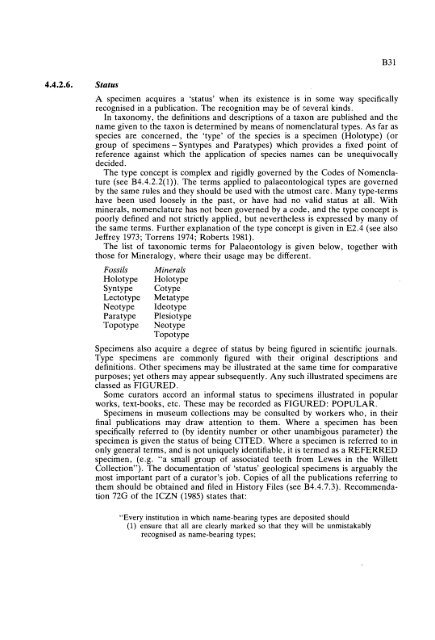GUIDELINES FOR THE CURATION OF GEOLOGICAL MATERIALS
GUIDELINES FOR THE CURATION OF GEOLOGICAL MATERIALS
GUIDELINES FOR THE CURATION OF GEOLOGICAL MATERIALS
Create successful ePaper yourself
Turn your PDF publications into a flip-book with our unique Google optimized e-Paper software.
4.4.2.6. Status<br />
A specimen acquires a 'status' when its existence is in some way specifically<br />
recognised in a publication. The recognition may be of several kinds.<br />
In taxonomy, the definitions and descriptions of a taxon are published and the<br />
name given to the taxon is determined by means of nomenclatural types. As far as<br />
species are concerned, the 'type' of the species is a specimen (Holotype) (or<br />
group of specimens - Syntypes and Paratypes) which provides a fixed point of<br />
reference against which the application of species names can be unequivocally<br />
decided.<br />
The type concept is complex and rigidly governed by the Codes of Nomenclature<br />
(see B4.4.2.2(1)). The terms applied to palaeontological types are governed<br />
by the same rules and they should be used with the utmost care. Many type-terms<br />
have been used loosely in the past, or have had no valid status at all. With<br />
minerals, nomenclature has not been governed by a code, and the type concept is<br />
poorly defined and not strictly applied, but nevertheless is expressed by many of<br />
the same terms. Further explanation of the type concept is given in E2.4 (see also<br />
Jeffrey 1973; Torrens 1974; Roberts 1981).<br />
The list of taxonomic terms for Palaeontology is given below, together with<br />
those for Mineralogy, where their usage may be different.<br />
Fossils<br />
Holotype<br />
Syntype<br />
Lectotype<br />
Neotype<br />
Paratype<br />
Topotype<br />
Minerals <br />
Holotype <br />
Cotype <br />
Metatype <br />
ldeotype <br />
Plesiotype <br />
Neotype <br />
Topotype<br />
Specimens also acquire a degree of status by being figured in scientific journals.<br />
Type specimens are commonly figured with their original descriptions and<br />
definitions. Other specimens may be illustrated at the same time for comparative<br />
purposes; yet others may appear subsequently. Any such illustrated specimens are<br />
classed as FIGURED.<br />
Some curators accord an informal status to specimens illustrated in popular<br />
works, text-books, etc. These may be recorded as FIGURED: POPULAR.<br />
Specimens in museum collections may be consulted by workers who, in their<br />
final publications may draw attention to them. Where a specimen has been<br />
specifically referred to (by identity number or other unambigous parameter) the<br />
specimen is given the status of being CITED. Where a specimen is referred to in<br />
only general terms, and is not uniquely identifiable, it is termed as a REFERRED<br />
specimen, (e.g. "a small group of associated teeth from Lewes in the Willett<br />
Collection"). The documentation of 'status' geological specimens is arguably the<br />
most important part of a curator's job. Copies of all the publications referring to<br />
them should be obtained and filed in History Files (see B4.4.7.3). Recommendation<br />
72G of the ICZN (1985) states that:<br />
"Every institution in which name-bearing types are deposited should<br />
(1) ensure that all are clearly marked so that they will be unmistakably<br />
recognised as name-bearing types;

















